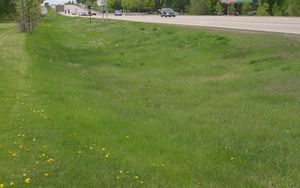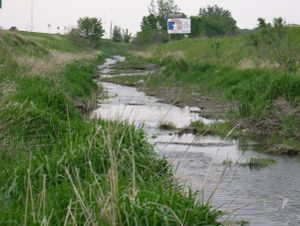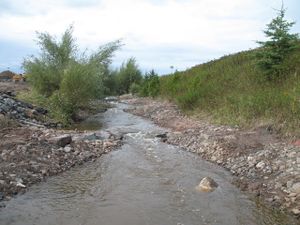
Difference between revisions of "Green Infrastructure benefits of vegetated swales"
| Line 70: | Line 70: | ||
==Design considerations for vegetated swales== | ==Design considerations for vegetated swales== | ||
Maximizing specific green infrastructure (GI) benefits of vegetated swales requires design considerations prior to constructing the practice. While site limitations cannot always be overcome, the following recommendations maximize the GI benefit of constructed ponds. | Maximizing specific green infrastructure (GI) benefits of vegetated swales requires design considerations prior to constructing the practice. While site limitations cannot always be overcome, the following recommendations maximize the GI benefit of constructed ponds. | ||
| + | |||
| + | {{alert|The following discussion focuses on design considerations. All benefits delivered by the practice require appropriate construction, operation, and maintenance of the practice. O&M considerations should be included during the design phase of a project. For information on O&M for GSI practices, see [[Operation and maintenance of green stormwater infrastructure best management practices]]|alert-warning}} | ||
| + | |||
*Water quality ([https://lcau.mit.edu/sites/lcau.mit.edu/files/attachments/project/Design%20Guidelines_Web%20Version.pdf Balderas-Guzman et al., 2018]; [https://www.sciencedirect.com/science/article/pii/S0043135412001406?casa_token=1FRCoY8pajoAAAAA:8ZAQDNwojU4fZjUJfQypQQLGR4bdrySQYd3BOUQ8Z0CNqC-0X1R8EymNULGP0cxt2-Wj4lVWhnQ]; [https://www.mdpi.com/2073-4441/10/2/134]). | *Water quality ([https://lcau.mit.edu/sites/lcau.mit.edu/files/attachments/project/Design%20Guidelines_Web%20Version.pdf Balderas-Guzman et al., 2018]; [https://www.sciencedirect.com/science/article/pii/S0043135412001406?casa_token=1FRCoY8pajoAAAAA:8ZAQDNwojU4fZjUJfQypQQLGR4bdrySQYd3BOUQ8Z0CNqC-0X1R8EymNULGP0cxt2-Wj4lVWhnQ]; [https://www.mdpi.com/2073-4441/10/2/134]). | ||
**If underlying soils are present, incorporate impermeable check dams into the design to promote infiltration. For wet swales and when underlying soils are less permeable, incorporate permeable check dams to slow water movement and enhance filtration of solids. | **If underlying soils are present, incorporate impermeable check dams into the design to promote infiltration. For wet swales and when underlying soils are less permeable, incorporate permeable check dams to slow water movement and enhance filtration of solids. | ||
Revision as of 18:06, 9 November 2022
The benefits delivered by vegetated swales depend on the type of swale. Swale types include dry swales, wet swales, and step-pools.
Dry swales, sometimes called grass swales, are similar to bioretention cells but are configured as shallow, linear channels. They typically have vegetative cover such as turf or native perennial grasses. Dry swales may be constructed as filtration or infiltration practices, depending on soils. If soils are highly permeable (A or B soils), runoff infiltrates into underlying soils. In less permeable soils, runoff is treated by engineered soil media and flows into an underdrain, which conveys treated runoff back to the conveyance system further downstream. Check dams incorporated into the swale design allow water to pool up and infiltrate into the underlying soil or engineered media, thus increasing the volume of water treated.
Wet swales occur when the water table is located very close to the surface or water does not readily drain out of the swale. A wet swale acts as a very long and linear shallow biofiltration or linear wetland treatment system. Wet swales do not provide volume reduction and have limited treatment capability. Incorporation of check dams into the design allows treatment of a portion or all of the water quality volume within a series of cells created by the check dams. Wet swales planted with emergent wetland plant species provide improved pollutant removal. Wet swales may be used as pretreatment practices. Wet swales are commonly used for drainage areas less than 5 acres in size.
Stormwater step pools are defined by its design features that address higher energy flows due to more dramatic slopes than dry or wet swales. Using a series of pools, riffle grade control, native vegetation and a sand seepage filter bed, flow velocities are reduced, treated, and, where applicable, infiltrated. to shallow groundwater. The physical characteristics of the stormwater step pools are similar to Rosgen A or B stream classification types, where “bedform occurs as a step/pool, cascading channel which often stores large amounts of sediment in the pools associated with debris dams” (Rosgen, 1996). These structures feature surface/subsurface runoff storage seams and an energy dissipation design that is aimed at attenuating the flow to a desired level through energy and hydraulic power equivalency principles (Anne Arundel County, 2009). Stormwater step pools are designed with a wide variety of native plant species depending on the hydraulic conditions and expected post-flow soil moisture at any given point within the stormwater step pool.
Contents
Green infrastructure and multiple benefits
Green infrastructure (GI) encompasses a wide array of practices, including stormwater management. Green stormwater infrastructure (GSI) encompasses a variety of practices primarily designed for managing stormwater runoff but that provide additional benefits such as habitat or aesthetic value.
There is no universal definition of GI or GSI (link here fore more information). Consequently, the terms are often interchanged, leading to confusion and misinterpretation. GSI practices are designed to function as stormwater practices first (e.g. flood control, treatment of runoff, volume control), but they can provide additional benefits. Though designed for stormwater function, GSI practices, where appropriate, should be designed to deliver multiple benefits (often termed "multiple stacked benefits". For more information on green infrastructure, ecosystem services, and sustainability, link to Multiple benefits of green infrastructure and role of green infrastructure in sustainability and ecosystem services.
| Benefit | Effectiveness | Notes |
|---|---|---|
| Water quality | Primary benefit is retention of sediment and associated pollutants; nutrient cycling in properly functioning wetlands; may export phosphorus if not designed and maintained properly. | |
| Water quantity/supply | Rate control, flooding benefit. | |
| Energy savings | ||
| Climate resiliency | Provides some rate control. Impacts on carbon sequestration are uncertain. | |
| Air quality | ||
| Habitat improvement | Use of perennial vegetation and certain media mixes promote invertebrate communities. | |
| Community livability | Aesthetically pleasing and can be incorporated into a wide range of land use settings. | |
| Health benefits | ||
| Economic savings | Generally provide cost savings vs. conventional practices over the life of the practice. | |
| Macroscale benefits | Individual practices are typically microscale, but multiple practices, when incorporated into a landscape design, provide macroscale benefits such as wildlife corridors. | |
| Level of benefit: ◯ - none; ◔ - small; ◑ - moderate; ◕ - large; ● - very high | ||
Green Infrastructure benefits of vegetated swales
The benefits delivered by swales depends on the type of swale - dry, wet, or step pool. The following discussion distinguishes the benefits of each type of swale.
- Water quality: ([1])
- Dry swales: Water quality benefits of dry swales primarily depend on the presence or absence of check dams and underlying soils. When impermeable check dams are used on permeable soils (hydrologic group A or B soils), swales act as infiltration practices and provide water quality benefits similar to other infiltration practices. If check dams are permeable, swales provide water quality treatment through sedimentation processes. When check dams are absent, swales may provide some filtration of water and some infiltration if underlying soils are permeable.
- Wet swales: Wet swales are generally ineffective for water quality treatment.
- Step pools: Similar to dry swales, step pools can provide effective water quality treatment when impermeable check dams are employed on permeable soils.
- Water quantity and hydrology: ([2])
- Swales without check dams convey stormwater and therefore provide limited hydrologic benefit, though on flatter slopes they provide some rate control. When check dams are employed, they can provide effective rate control if the check dams are permeable, or retention through infiltration if check dams are impermeable.
- Energy:
- Climate resiliency: As discussed above, the type and configuration of swales varies widely and affects the benefits delivered by the practice.
- With respect to flood control, dry swales and step pools with impermeable check dams over permeable soils allows retention of runoff through infiltration. Use of permeable check dams provides some rate control.
- Wet swales provide some rate control to help mitigate flood potential.
- Carbon density in swales appears to be similar to that found in native grassland soils. Wet swales may provide greater carbon density than dry swales, though the data are inconclusive. In most studies, carbon sequestration by grassed swales did not offset carbon loss from construction. However, grassed swales are among the most effective stormwater practices for sequestering carbon ([3]; [4]; [5]; [6])
- Air quality: benefits are largely indirect, such as carbon sequestration; potential concerns with improperly maintained wetlands releasing methane.
- Habitat improvement:
- Habitat benefits of swales are a function of the vegetation incorporated into the design. Native plants, particularly grasses, provide habitat for birds and insects, including pollinators and invertebrates, and for small mammals.
- Habitat benefits vary significantly between wet and dry swales because of the differing vegetation. Wet swales provide habitat benefits similar to those for near-shore and littoral areas in constructed ponds and wetlands, while dry swales typically provide habitat for upland or transition species that can tolerate dry and wet conditions. For more information on vegetation for swales, see Plants for swales.
- Community livability: Vegetated swales, or bioswales as they are often called, are an aesthetically pleasing practice that can easily be incorporated into various landscapes. A variety of vegetation can also be used, including perennial plants, shrubs, and trees in dry swales and wetland vegetation in wet swales.
- Health benefits: Green spaces may improve mental and physical health for residents and reduce crime (Barton and Rogerson, 2017).
- Economic savings: Properly designed and integrated bioswale practices provide life cycle cost savings. Well designed and maintained bioswales practices may increase property values.
- Macroscale benefits:
Design considerations for vegetated swales
Maximizing specific green infrastructure (GI) benefits of vegetated swales requires design considerations prior to constructing the practice. While site limitations cannot always be overcome, the following recommendations maximize the GI benefit of constructed ponds.
- Water quality (Balderas-Guzman et al., 2018; [7]; [8]).
- If underlying soils are present, incorporate impermeable check dams into the design to promote infiltration. For wet swales and when underlying soils are less permeable, incorporate permeable check dams to slow water movement and enhance filtration of solids.
- For infiltration swales (swales without an underdrain), use a high organic matter media to maximize pollutant removal
- Utilize side slopes as pretreatment by incorporating appropriate vegetation and geometry (e.g. dense grass, increased surface roughness, gentler and longer slopes)
- Select vegetation with dense root systems
- For swales (swales with an underdrain), use a media mix that does not export phosphorus or use an amendment to attenuate phosphorus.
- Water quantity/supply
- If underlying soils are present, incorporate impermeable check dams into the design to promote infiltration. For wet swales and when underlying soils are less permeable, incorporate permeable check dams to slow water movement and enhance filtration of solids.
- Climate resiliency
- Promote carbon sequestration by incorporating trees and shrubs when feasible.
- Utilize deep-rooted, perennial vegetation to promote carbon sequestration.
- Habitat
- Utilize perennial vegetation that provides habitat benefits, such as food, cover, and pollination potential.
- Utilize a diversity of vegetation, including perennial grasses
- Consider salt tolerance of vegetation when swales are used for conveying water in areas receiving chloride deicer applications
- Community livability
- Choose locations for that enhance aesthetics but provide the conveyance function of swales
- Choose vegetation that mimics a native landscape, such as tall grass prairie or mixed woodland when trees and shrubs can be incorporated into the design
- Evaluate the placement of vegetation within the swale. Place plants at irregular intervals to replicate a natural setting. Trees should be placed on the perimeter of the area to provide shade and shelter from the wind. Trees and shrubs can be sheltered from damaging flows if they are placed away from the conveyance path. In cold climates, species that are more tolerant to cold winds, such as evergreens, should be placed in windier areas of the site.
- Health benefits
- Economic benefits (Constructed Wetlands: The Economic Benefits of Runoff Controls National Association of Certified Home Inspectors)




